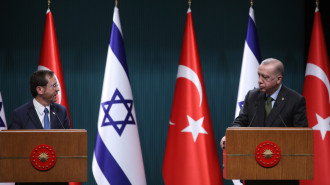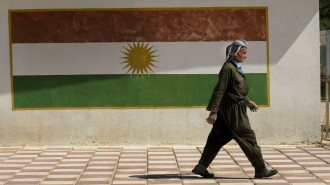
How drone footage became a potent tool in Middle East warfare

Hezbollah in Lebanon and the Houthis in Yemen this month released surveillance footage of strategic sites in Israel and Saudi Arabia taken by their drones in a clear message to those well-armed Middle Eastern powers.
On 9 July, Hezbollah released drone footage it had taken of military and intelligence sites in northern Israel and the occupied Golan Heights less than a month after publishing a similar video of the Israeli coastal city of Haifa.
The group concluded its latest video with footage of an Israeli city, which it said will feature in an upcoming third video.
Two days earlier, the Houthis released a similar video showing drone footage shot by the group of Saudi Arabia’s primary air and seaports.
“There is no question that both the Houthis and Hezbollah have throughout the years acquired more advanced surveillance capabilities and upgraded their already existing ones, as demonstrated by the videos they recently released,” Freddy Khoueiry, a global security analyst for the Middle East and North Africa at the risk intelligence company RANE, told The New Arab.
“Their wide range of drone and missile capabilities also means that they could harm Israeli and Saudi strategic assets,” he added.
Hezbollah has engaged in border clashes with the Israeli military since 8 October. During these clashes, Hezbollah has launched barrages of missiles, rockets, and drones increasingly deeper into northern Israel.
The Houthis and Saudi Arabia fought a long war beginning in 2015 but have maintained a ceasefire since 2022 and engaged in peace talks. In the latter stages of that conflict, the Houthis demonstrated their capabilities to strike targets deep inside Saudi Arabia with precision using drones and ballistic missiles.
Consequently, its latest video is no empty threat.
“Hezbollah is generally seeking to become more proficient in the use of a variety of drone platforms, ranging from Iranian-made attack drones to commercial hobbyist drones fitted with high-resolution cameras,” Nicholas Heras, senior director of strategy and innovation at the New Lines Institute, told TNA.
“Hezbollah does not need drones for surveillance of strategic, fixed targets such as Israeli civilian infrastructure or military bases because it can use readily available open-source imagery and geo-location for that purpose,” he said.
“Hezbollah is trying to build proficiency in using drones in a tactical context, to support dynamic operations in a battlespace, and to identify mobile targets,” Heras added. “Thus far, Hezbollah has shown only a beginner’s skillset with this use of drones on the battlefield.”
The Houthis, on the other hand, have shown more proficiency in using their drones for such dynamic operations, honed from years of fighting Saudi Arabia and its allies in the Yemen conflict.
“The Houthis are more advanced than Hezbollah in the use of drones, which is why Iran is trying to facilitate the transfer of knowledge from Yemen to Lebanon,” Heras said.
|
|
Khoueiry noted that while the Houthis previously demonstrated their ability to strike strategic Saudi assets before the 2022 ceasefire, Hezbollah’s attacks in the current conflict have shown it can “detect and damage” Israeli targets despite Israel’s advanced air defences.
“Though there are also limits to these groups’ advanced capabilities, such as the number of advanced missiles that these groups have and the amount of damage these missiles could do should they successfully hit their targets,” he said.
The RANE analyst noted that the “asymmetry” between these groups and “the more technologically advanced” Israeli and Saudi militaries make “real-time footage” like the ones released this month highly politically significant and valuable.
“These are not only used for military purposes but also to fuel domestic audiences into supporting these groups by showcasing their deterrence capabilities, and that should there be a need, they will not hesitate to strike these sensitive targets,” Khoueiry said.
“Being the underdogs in such fights but showing that they have acquired these capabilities despite the difference in financial and technological means boosts their domestic popularity and their messages of deterrence.”
Hezbollah and the Houthis are not the only non-state actors in the region showcasing their unmanned aerial vehicle capabilities. For months, the Kurdistan Workers’ Party, commonly known by its Kurdish PKK acronym, has released several videos it claims show its capacity to shoot down Turkish military drones, including the Bayraktar TB2 and Anka drones, over Iraqi Kurdistan.
Additionally, as Turkey has intensified its campaign against the group this summer, the PKK has also said it is striking Turkish ground forces with drones of its own, specifically cheap first-person view drones commonly used in the Ukraine war.
“Firstly, as the Turkish army continues to advance and degrade the PKK’s presence and capabilities in Iraqi Kurdistan, it is very logical for the PKK to increase their usage of FPV drones that are cheap and easy to acquire and arm,” Khoueiry said.
“Additionally, as the war in Ukraine has shown us, these drones are highly accurate and lethal, giving an advantage to those wielding them and also a disadvantage to those defending against them,” he added. “Their use is highly effective for pinpointing targets such as troops or tanks and infantry fighting vehicles without cover.”
Unlike the case with Hezbollah and the Houthis, there is no indication the PKK has used such drones for surveillance or attacks on military bases in southeast Turkey, although the group appeared to attempt drone attacks on Turkey’s Diyarbakir airbase in May 2021. Nevertheless, footage of these drones in action serves a purpose that’s not overly dissimilar.
“These drones also serve propaganda purposes, such as, for example, when Hamas publishes a video of an FPV drone dropping a bomb on an IDF squad or an Israeli Merkava tank, showcasing that they have inventive and lethal ways to fight,” Khoueiry said.
“To address this, Turkey has been developing for the past few years its anti-drone defence capabilities, such as the Aselsan IHTAR Anti-Drone System, which counters small UAVs in urban and rural environments.”
Paul Iddon is a freelance journalist based in Erbil, Iraqi Kurdistan, who writes about Middle East affairs.
Follow him on Twitter: @pauliddon




 Follow the Middle East's top stories in English at The New Arab on Google News
Follow the Middle East's top stories in English at The New Arab on Google News


